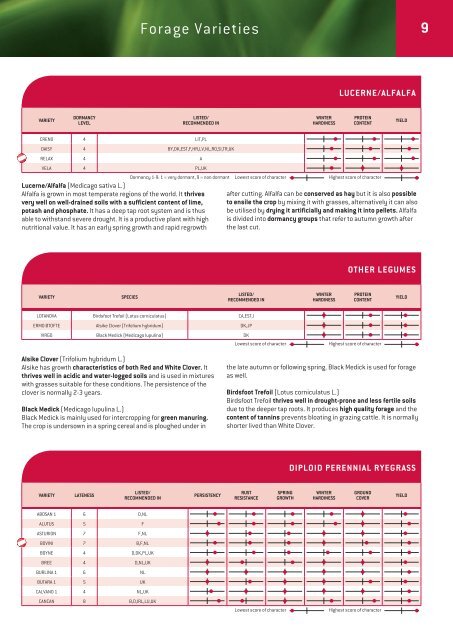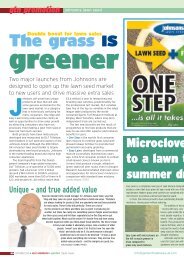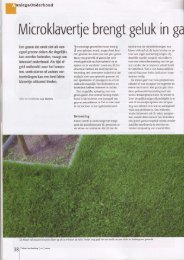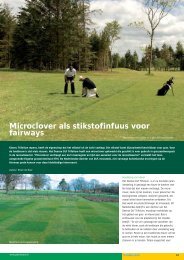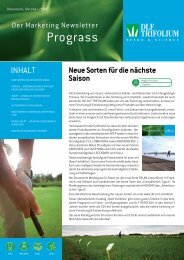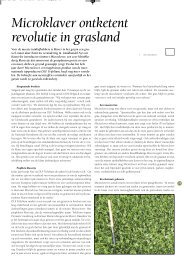Seed Varieties - dlf-trifolium
Seed Varieties - dlf-trifolium
Seed Varieties - dlf-trifolium
You also want an ePaper? Increase the reach of your titles
YUMPU automatically turns print PDFs into web optimized ePapers that Google loves.
NEW<br />
VARIETY<br />
DORMANCY<br />
LEVEL<br />
Forage <strong>Varieties</strong><br />
LISTED/<br />
RECOMMENDED IN<br />
CRENO 4 LIT,PL<br />
DAISY 4 BY,DK,EST,F,HR,LV,NL,RO,SI,TR,UK<br />
RELAX 4 A<br />
VELA 4 PL,UK<br />
Lucerne/Alfalfa (Medicago sativa L.)<br />
Alfalfa is grown in most temperate regions of the world. It thrives<br />
very well on well-drained soils with a sufficient content of lime,<br />
potash and phosphate. It has a deep tap root system and is thus<br />
able to withstand severe drought. It is a productive plant with high<br />
nutritional value. It has an early spring growth and rapid regrowth<br />
Alsike Clover (Trifolium hybridum L.)<br />
Alsike has growth characteristics of both Red and White Clover. It<br />
thrives well in acidic and water-logged soils and is used in mixtures<br />
with grasses suitable for these conditions. The persistence of the<br />
clover is normally 2-3 years.<br />
Black Medick (Medicago lupulina L.)<br />
Black Medick is mainly used for intercropping for green manuring.<br />
The crop is undersown in a spring cereal and is ploughed under in<br />
NEW<br />
VARIETY SPECIES<br />
WINTER<br />
HARDINESS<br />
LUCERNE/ALFALFA<br />
PROTEIN<br />
CONTENT<br />
YIELD<br />
after cutting. Alfalfa can be conserved as hay but it is also possible<br />
to ensile the crop by mixing it with grasses, alternatively it can also<br />
be utilised by drying it artificially and making it into pellets. Alfalfa<br />
is divided into dormancy groups that refer to autumn growth after<br />
the last cut.<br />
LISTED/<br />
RECOMMENDED IN<br />
LOTANOVA Birdsfoot Trefoil (Lotus corniculatus) CA,EST,I<br />
ERMO ØTOFTE Alsike Clover (Trifolium hybridum) DK,JP<br />
VIRGO Black Medick (Medicago lupulina) DK<br />
VARIETY LATENESS<br />
Dormancy 1-9: 1 = very dormant, 9 = non dormant Lowest score of character Highest score of character<br />
LISTED/<br />
RECOMMENDED IN<br />
ABOSAN 1 6 D,NL<br />
ALUTUS 5 F<br />
ASTURION 7 F,NL<br />
BOVINI 7 B,F,NL<br />
BOYNE 4 D,DK,PL,UK<br />
BREE 4 D,NL,UK<br />
BURLINA 1 6 NL<br />
BUTARA 1 5 UK<br />
CALVANO 1 4 NL,UK<br />
CANCAN 8 B,D,IRL,LU,UK<br />
PERSISTENCY<br />
WINTER<br />
HARDINESS<br />
OTHER LEGUMES<br />
PROTEIN<br />
CONTENT<br />
Lowest score of character Highest score of character<br />
YIELD<br />
the late autumn or following spring. Black Medick is used for forage<br />
as well.<br />
Birdsfoot Trefoil (Lotus corniculatus L.)<br />
Birdsfoot Trefoil thrives well in drought-prone and less fertile soils<br />
due to the deeper tap roots. It produces high quality forage and the<br />
content of tannins prevents bloating in grazing cattle. It is normally<br />
shorter lived than White Clover.<br />
RUST<br />
RESISTANCE<br />
SPRING<br />
GROWTH<br />
DIPLOID PERENNIAL RYEGRASS<br />
WINTER<br />
HARDINESS<br />
GROUND<br />
COVER<br />
Lowest score of character Highest score of character<br />
YIELD<br />
9


